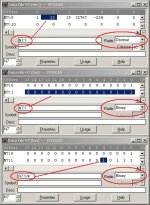I've only used AB a few times but I think what you need to understand is the relationship between integers and binary.
If AB is the same as Siemens then, although N7:0 is holding a word, you can still use the various 'bits' of that word on bit level.
Let me explain a little and if I'm wrong with this then I'm sure one of the more experienced AB programmer will let you know to ignore this post... however, as I understand it...
N7:0/1 N7:100/9 N7:1/7
--| |-------|/|---------------(L)
We have established that N7:0 holds an integer ie a whole number.
If I load a 13 (for example) into N7:0
Then N7:0 would look like this (in binary)
0000 0000 0000 1101
So the bits that would be on would be: N7:0/0 N7:0/2 and N7:0/3
So, in your example above, if we assume that we have nothing in N7:100, then if we loaded (or moved) a 2 into N7:0 then N7:1/7 would Latch in.
As I said right at the start of this post, I'm only assuming that this is the way that AB does it, I'm a lot more familiar with Siemens but it sounds logical to me.
Try to get your head around the relationship between bits and words and the value of those words in Base 10 (ie. Decimal)







